Comprehensive Report: Data Elements in Concert Ticket Ordering System
VerifiedAdded on 2022/09/16
|9
|1719
|22
Report
AI Summary
This report provides a comprehensive analysis of a concert ticket ordering system, detailing its various components and data relationships. The system is broken down into three main sections: concerts, tickets, and customers and orders. The concerts section includes tables for genre, artist, role, and concert_role, managing concert-specific information. The tickets section features tables for tickets and ticket_category, ensuring accurate seat assignments and ticket management. The customers and orders section encompasses tables for customers, customer_order, and order_ticket, facilitating order processing and customer management. The report addresses a research question involving a customer's ticket retrieval, highlighting the data elements stored on order and shipping forms. The minimum data elements required for the shipping form are Customer Number, Customer Name, Customer Address, and Concert Dates, while the order form requires Customer Number, Customer Name, Customer Telephone, Number of Concerts, Concert ID, Concert Dates, Number of Tickets and Concert Seat Location for Each Ticket. The report concludes that Gregg Baker likely provided information such as Customer Name, Customer Telephone, Number of Concerts, and the Number of Tickets to retrieve his order information.
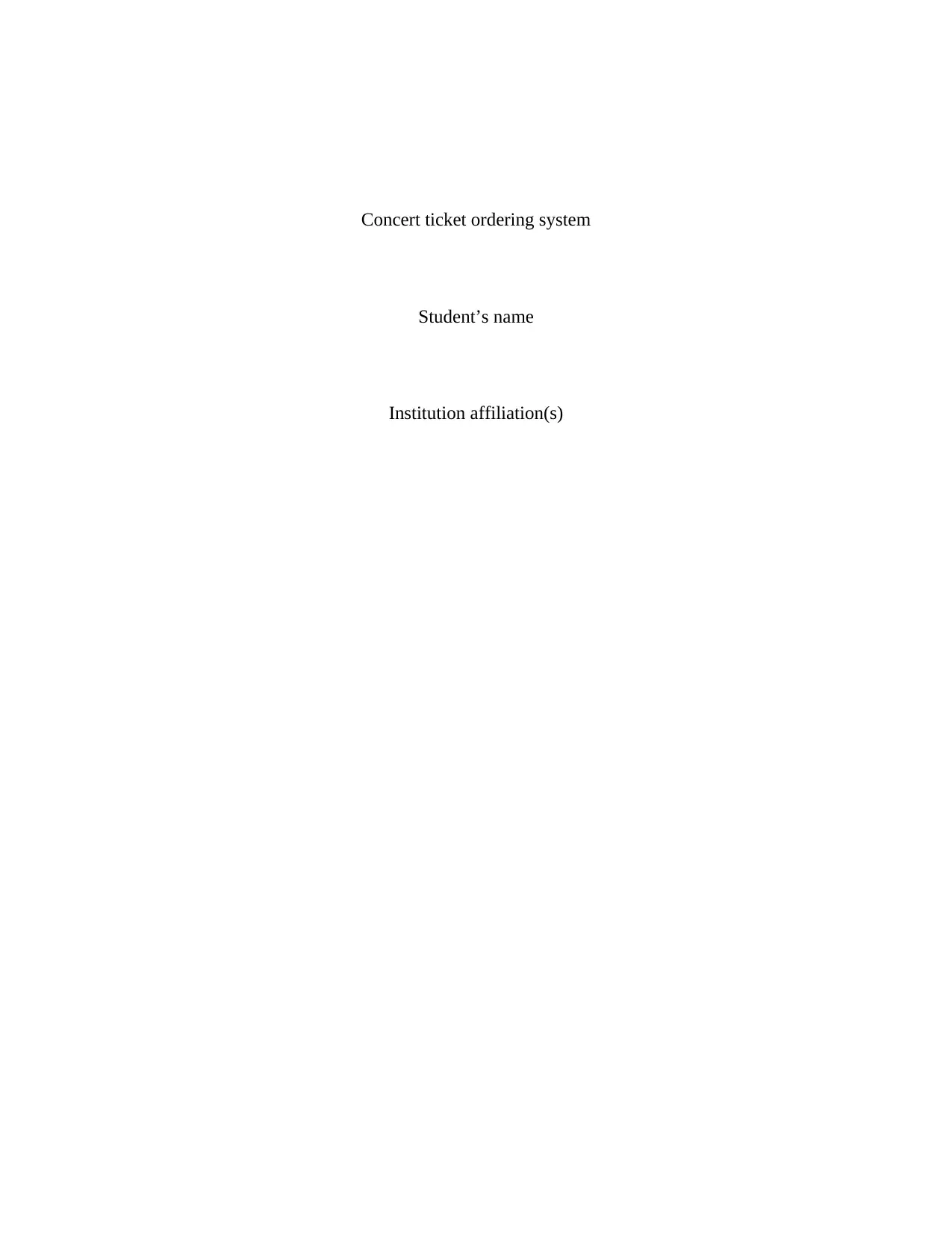
Concert ticket ordering system
Student’s name
Institution affiliation(s)
Student’s name
Institution affiliation(s)
Paraphrase This Document
Need a fresh take? Get an instant paraphrase of this document with our AI Paraphraser
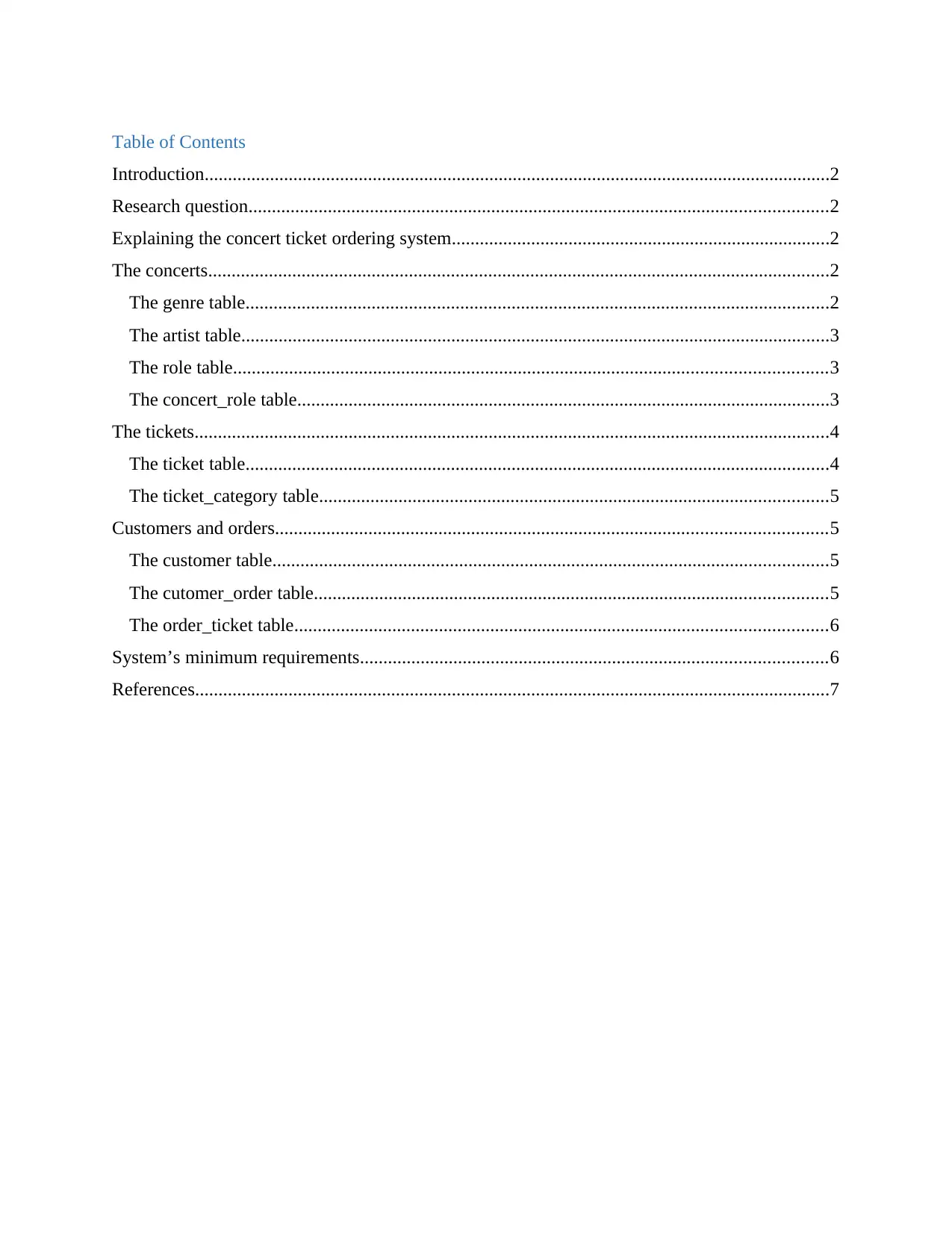
Table of Contents
Introduction......................................................................................................................................2
Research question............................................................................................................................2
Explaining the concert ticket ordering system.................................................................................2
The concerts.....................................................................................................................................2
The genre table.............................................................................................................................2
The artist table..............................................................................................................................3
The role table...............................................................................................................................3
The concert_role table..................................................................................................................3
The tickets........................................................................................................................................4
The ticket table.............................................................................................................................4
The ticket_category table.............................................................................................................5
Customers and orders......................................................................................................................5
The customer table.......................................................................................................................5
The cutomer_order table..............................................................................................................5
The order_ticket table..................................................................................................................6
System’s minimum requirements....................................................................................................6
References........................................................................................................................................7
Introduction......................................................................................................................................2
Research question............................................................................................................................2
Explaining the concert ticket ordering system.................................................................................2
The concerts.....................................................................................................................................2
The genre table.............................................................................................................................2
The artist table..............................................................................................................................3
The role table...............................................................................................................................3
The concert_role table..................................................................................................................3
The tickets........................................................................................................................................4
The ticket table.............................................................................................................................4
The ticket_category table.............................................................................................................5
Customers and orders......................................................................................................................5
The customer table.......................................................................................................................5
The cutomer_order table..............................................................................................................5
The order_ticket table..................................................................................................................6
System’s minimum requirements....................................................................................................6
References........................................................................................................................................7
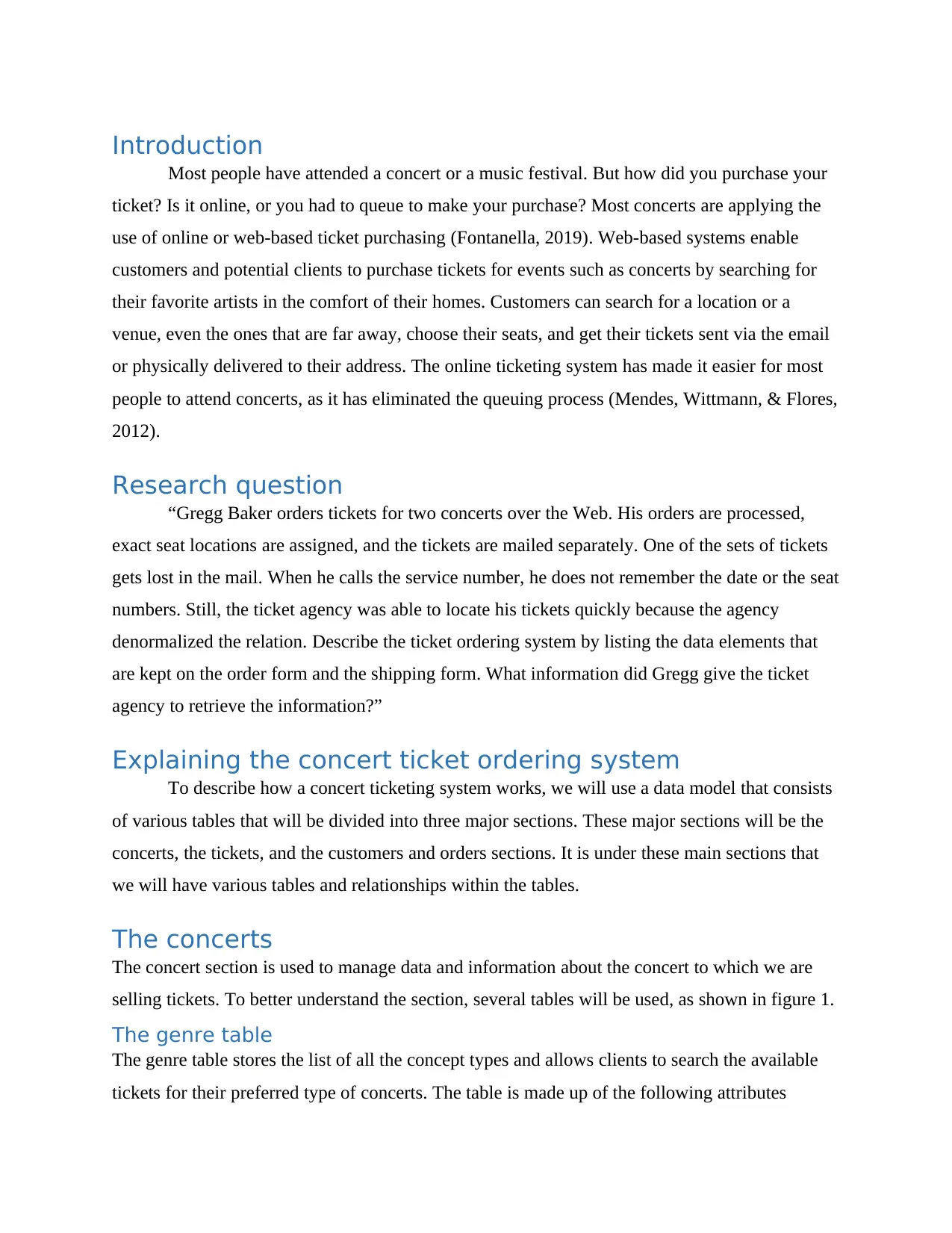
Introduction
Most people have attended a concert or a music festival. But how did you purchase your
ticket? Is it online, or you had to queue to make your purchase? Most concerts are applying the
use of online or web-based ticket purchasing (Fontanella, 2019). Web-based systems enable
customers and potential clients to purchase tickets for events such as concerts by searching for
their favorite artists in the comfort of their homes. Customers can search for a location or a
venue, even the ones that are far away, choose their seats, and get their tickets sent via the email
or physically delivered to their address. The online ticketing system has made it easier for most
people to attend concerts, as it has eliminated the queuing process (Mendes, Wittmann, & Flores,
2012).
Research question
“Gregg Baker orders tickets for two concerts over the Web. His orders are processed,
exact seat locations are assigned, and the tickets are mailed separately. One of the sets of tickets
gets lost in the mail. When he calls the service number, he does not remember the date or the seat
numbers. Still, the ticket agency was able to locate his tickets quickly because the agency
denormalized the relation. Describe the ticket ordering system by listing the data elements that
are kept on the order form and the shipping form. What information did Gregg give the ticket
agency to retrieve the information?”
Explaining the concert ticket ordering system
To describe how a concert ticketing system works, we will use a data model that consists
of various tables that will be divided into three major sections. These major sections will be the
concerts, the tickets, and the customers and orders sections. It is under these main sections that
we will have various tables and relationships within the tables.
The concerts
The concert section is used to manage data and information about the concert to which we are
selling tickets. To better understand the section, several tables will be used, as shown in figure 1.
The genre table
The genre table stores the list of all the concept types and allows clients to search the available
tickets for their preferred type of concerts. The table is made up of the following attributes
Most people have attended a concert or a music festival. But how did you purchase your
ticket? Is it online, or you had to queue to make your purchase? Most concerts are applying the
use of online or web-based ticket purchasing (Fontanella, 2019). Web-based systems enable
customers and potential clients to purchase tickets for events such as concerts by searching for
their favorite artists in the comfort of their homes. Customers can search for a location or a
venue, even the ones that are far away, choose their seats, and get their tickets sent via the email
or physically delivered to their address. The online ticketing system has made it easier for most
people to attend concerts, as it has eliminated the queuing process (Mendes, Wittmann, & Flores,
2012).
Research question
“Gregg Baker orders tickets for two concerts over the Web. His orders are processed,
exact seat locations are assigned, and the tickets are mailed separately. One of the sets of tickets
gets lost in the mail. When he calls the service number, he does not remember the date or the seat
numbers. Still, the ticket agency was able to locate his tickets quickly because the agency
denormalized the relation. Describe the ticket ordering system by listing the data elements that
are kept on the order form and the shipping form. What information did Gregg give the ticket
agency to retrieve the information?”
Explaining the concert ticket ordering system
To describe how a concert ticketing system works, we will use a data model that consists
of various tables that will be divided into three major sections. These major sections will be the
concerts, the tickets, and the customers and orders sections. It is under these main sections that
we will have various tables and relationships within the tables.
The concerts
The concert section is used to manage data and information about the concert to which we are
selling tickets. To better understand the section, several tables will be used, as shown in figure 1.
The genre table
The genre table stores the list of all the concept types and allows clients to search the available
tickets for their preferred type of concerts. The table is made up of the following attributes
⊘ This is a preview!⊘
Do you want full access?
Subscribe today to unlock all pages.

Trusted by 1+ million students worldwide
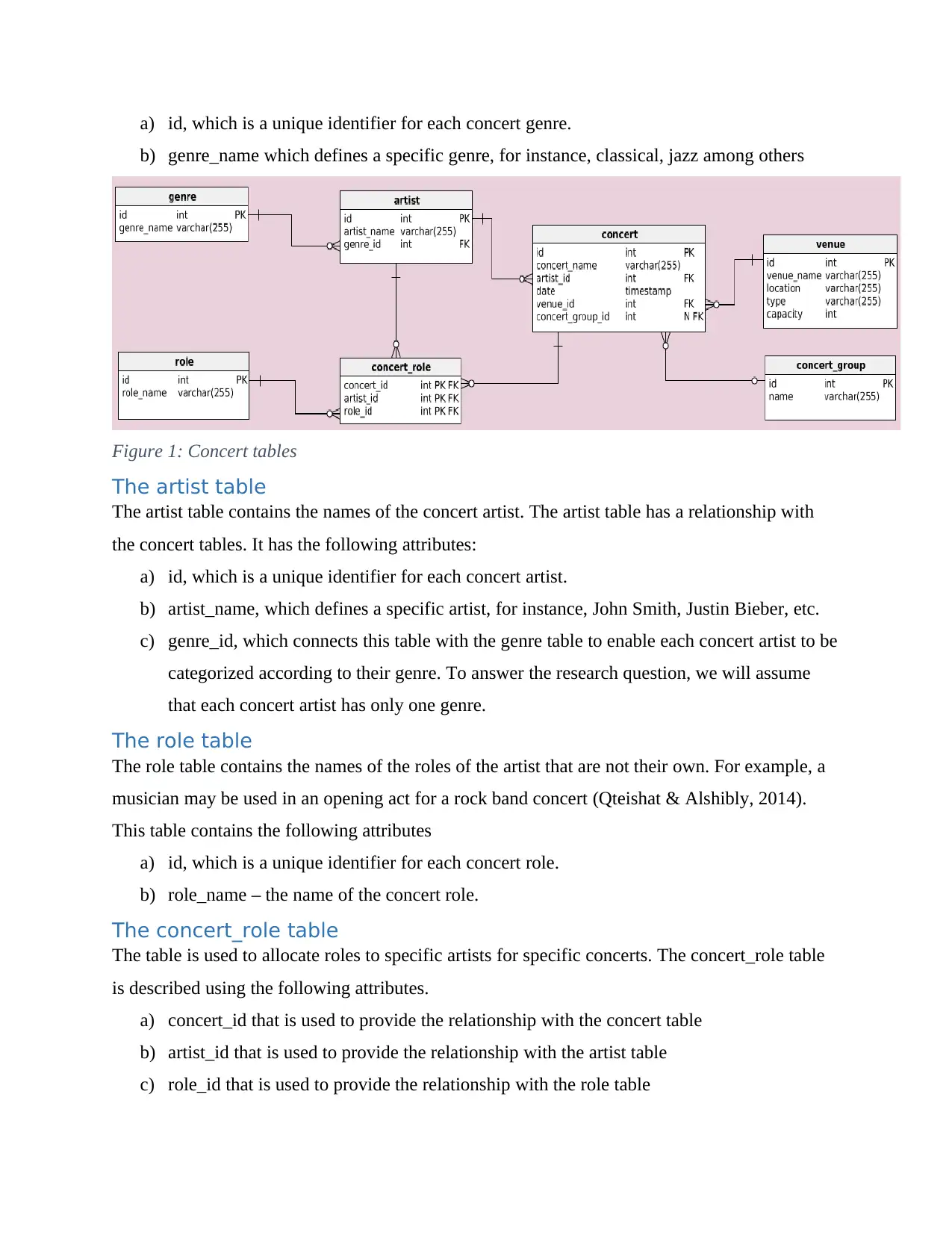
a) id, which is a unique identifier for each concert genre.
b) genre_name which defines a specific genre, for instance, classical, jazz among others
Figure 1: Concert tables
The artist table
The artist table contains the names of the concert artist. The artist table has a relationship with
the concert tables. It has the following attributes:
a) id, which is a unique identifier for each concert artist.
b) artist_name, which defines a specific artist, for instance, John Smith, Justin Bieber, etc.
c) genre_id, which connects this table with the genre table to enable each concert artist to be
categorized according to their genre. To answer the research question, we will assume
that each concert artist has only one genre.
The role table
The role table contains the names of the roles of the artist that are not their own. For example, a
musician may be used in an opening act for a rock band concert (Qteishat & Alshibly, 2014).
This table contains the following attributes
a) id, which is a unique identifier for each concert role.
b) role_name – the name of the concert role.
The concert_role table
The table is used to allocate roles to specific artists for specific concerts. The concert_role table
is described using the following attributes.
a) concert_id that is used to provide the relationship with the concert table
b) artist_id that is used to provide the relationship with the artist table
c) role_id that is used to provide the relationship with the role table
b) genre_name which defines a specific genre, for instance, classical, jazz among others
Figure 1: Concert tables
The artist table
The artist table contains the names of the concert artist. The artist table has a relationship with
the concert tables. It has the following attributes:
a) id, which is a unique identifier for each concert artist.
b) artist_name, which defines a specific artist, for instance, John Smith, Justin Bieber, etc.
c) genre_id, which connects this table with the genre table to enable each concert artist to be
categorized according to their genre. To answer the research question, we will assume
that each concert artist has only one genre.
The role table
The role table contains the names of the roles of the artist that are not their own. For example, a
musician may be used in an opening act for a rock band concert (Qteishat & Alshibly, 2014).
This table contains the following attributes
a) id, which is a unique identifier for each concert role.
b) role_name – the name of the concert role.
The concert_role table
The table is used to allocate roles to specific artists for specific concerts. The concert_role table
is described using the following attributes.
a) concert_id that is used to provide the relationship with the concert table
b) artist_id that is used to provide the relationship with the artist table
c) role_id that is used to provide the relationship with the role table
Paraphrase This Document
Need a fresh take? Get an instant paraphrase of this document with our AI Paraphraser
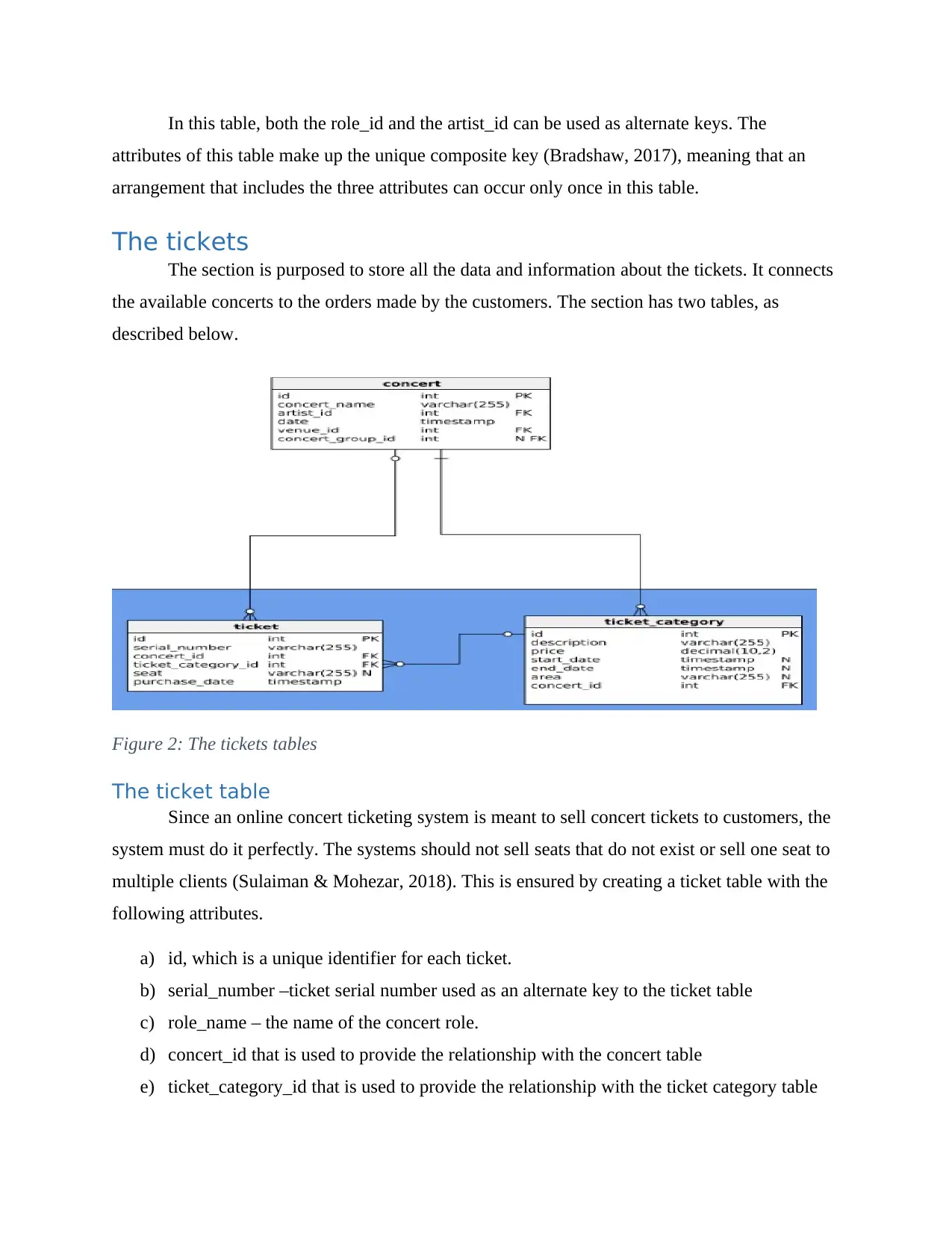
In this table, both the role_id and the artist_id can be used as alternate keys. The
attributes of this table make up the unique composite key (Bradshaw, 2017), meaning that an
arrangement that includes the three attributes can occur only once in this table.
The tickets
The section is purposed to store all the data and information about the tickets. It connects
the available concerts to the orders made by the customers. The section has two tables, as
described below.
Figure 2: The tickets tables
The ticket table
Since an online concert ticketing system is meant to sell concert tickets to customers, the
system must do it perfectly. The systems should not sell seats that do not exist or sell one seat to
multiple clients (Sulaiman & Mohezar, 2018). This is ensured by creating a ticket table with the
following attributes.
a) id, which is a unique identifier for each ticket.
b) serial_number –ticket serial number used as an alternate key to the ticket table
c) role_name – the name of the concert role.
d) concert_id that is used to provide the relationship with the concert table
e) ticket_category_id that is used to provide the relationship with the ticket category table
attributes of this table make up the unique composite key (Bradshaw, 2017), meaning that an
arrangement that includes the three attributes can occur only once in this table.
The tickets
The section is purposed to store all the data and information about the tickets. It connects
the available concerts to the orders made by the customers. The section has two tables, as
described below.
Figure 2: The tickets tables
The ticket table
Since an online concert ticketing system is meant to sell concert tickets to customers, the
system must do it perfectly. The systems should not sell seats that do not exist or sell one seat to
multiple clients (Sulaiman & Mohezar, 2018). This is ensured by creating a ticket table with the
following attributes.
a) id, which is a unique identifier for each ticket.
b) serial_number –ticket serial number used as an alternate key to the ticket table
c) role_name – the name of the concert role.
d) concert_id that is used to provide the relationship with the concert table
e) ticket_category_id that is used to provide the relationship with the ticket category table
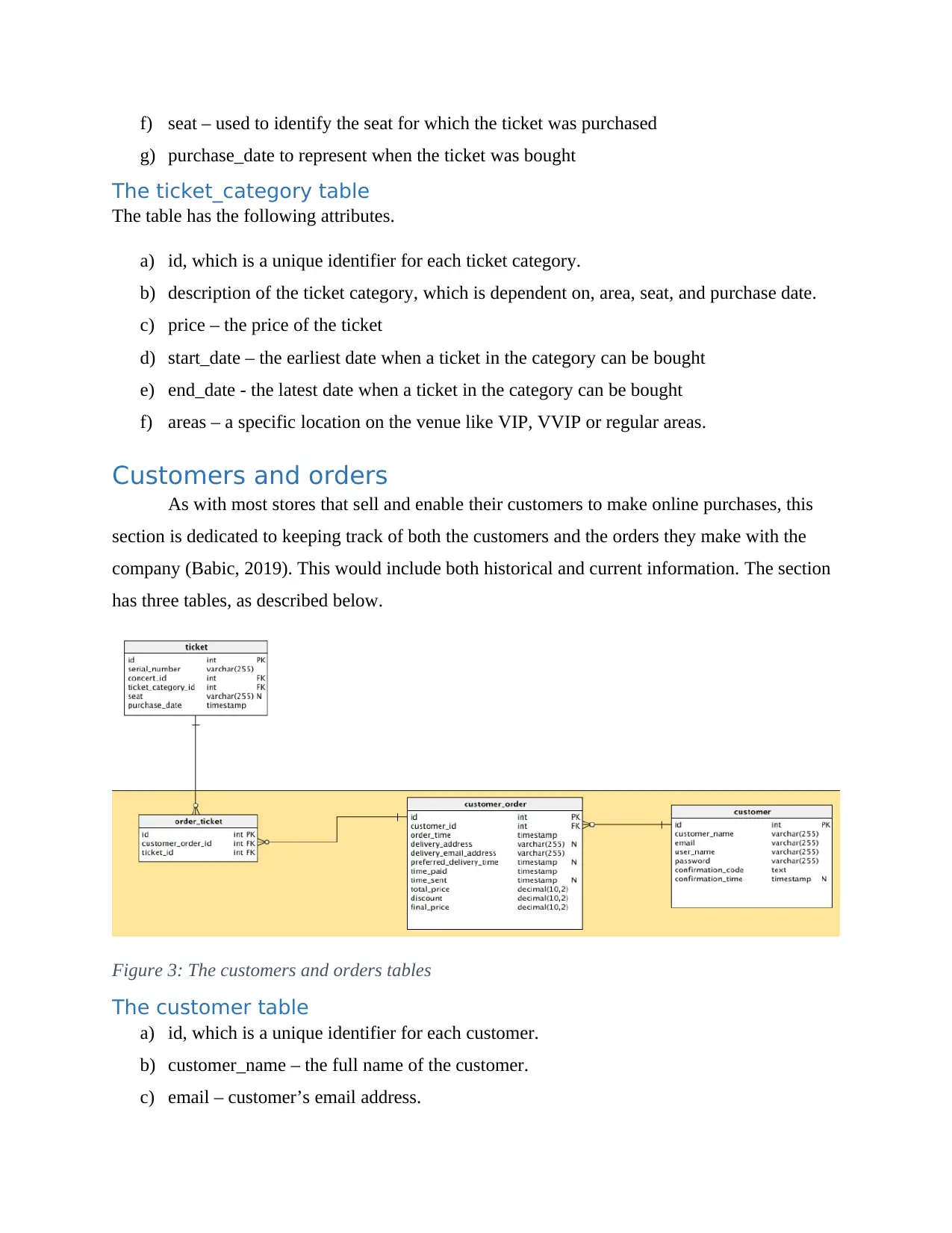
f) seat – used to identify the seat for which the ticket was purchased
g) purchase_date to represent when the ticket was bought
The ticket_category table
The table has the following attributes.
a) id, which is a unique identifier for each ticket category.
b) description of the ticket category, which is dependent on, area, seat, and purchase date.
c) price – the price of the ticket
d) start_date – the earliest date when a ticket in the category can be bought
e) end_date - the latest date when a ticket in the category can be bought
f) areas – a specific location on the venue like VIP, VVIP or regular areas.
Customers and orders
As with most stores that sell and enable their customers to make online purchases, this
section is dedicated to keeping track of both the customers and the orders they make with the
company (Babic, 2019). This would include both historical and current information. The section
has three tables, as described below.
Figure 3: The customers and orders tables
The customer table
a) id, which is a unique identifier for each customer.
b) customer_name – the full name of the customer.
c) email – customer’s email address.
g) purchase_date to represent when the ticket was bought
The ticket_category table
The table has the following attributes.
a) id, which is a unique identifier for each ticket category.
b) description of the ticket category, which is dependent on, area, seat, and purchase date.
c) price – the price of the ticket
d) start_date – the earliest date when a ticket in the category can be bought
e) end_date - the latest date when a ticket in the category can be bought
f) areas – a specific location on the venue like VIP, VVIP or regular areas.
Customers and orders
As with most stores that sell and enable their customers to make online purchases, this
section is dedicated to keeping track of both the customers and the orders they make with the
company (Babic, 2019). This would include both historical and current information. The section
has three tables, as described below.
Figure 3: The customers and orders tables
The customer table
a) id, which is a unique identifier for each customer.
b) customer_name – the full name of the customer.
c) email – customer’s email address.
⊘ This is a preview!⊘
Do you want full access?
Subscribe today to unlock all pages.

Trusted by 1+ million students worldwide
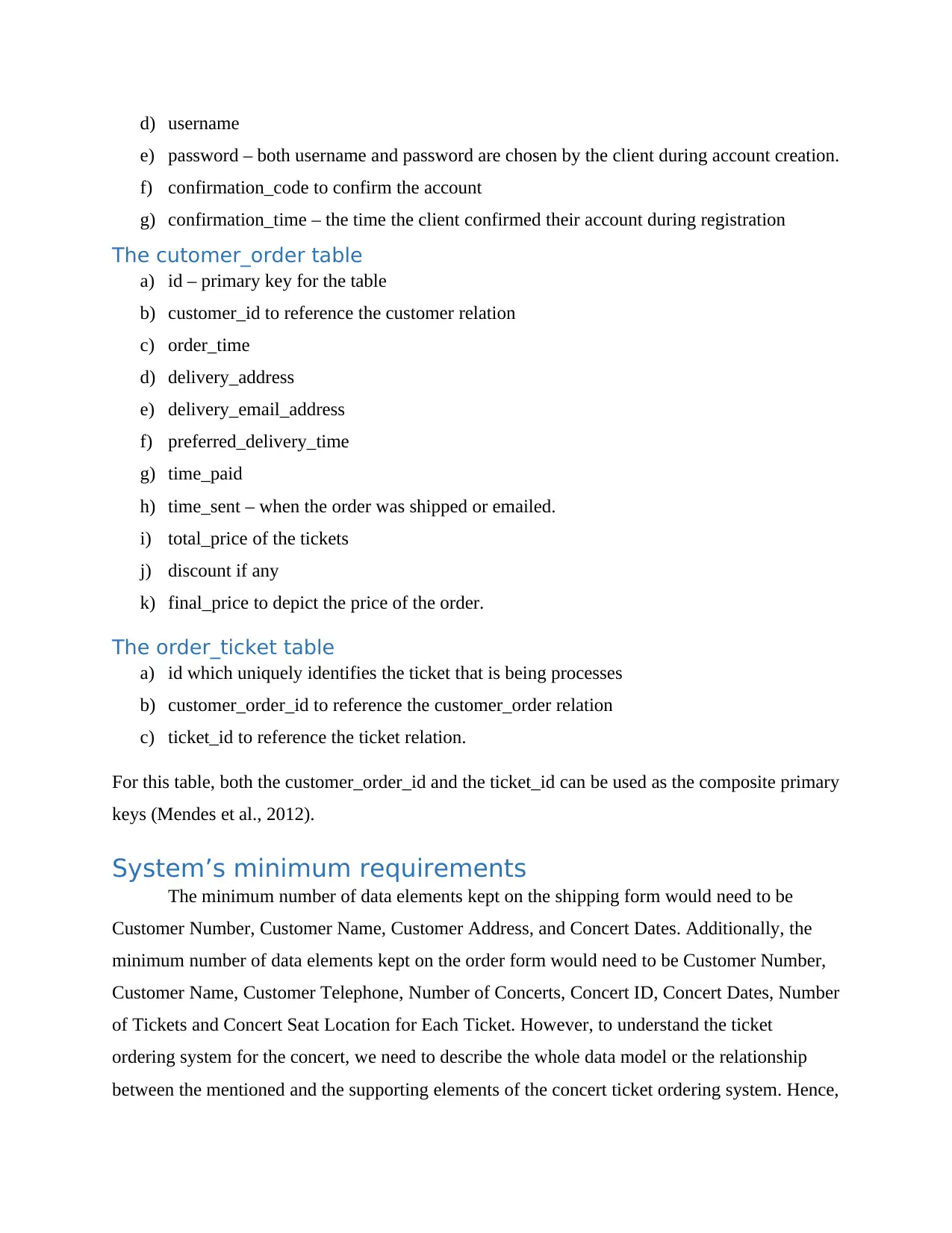
d) username
e) password – both username and password are chosen by the client during account creation.
f) confirmation_code to confirm the account
g) confirmation_time – the time the client confirmed their account during registration
The cutomer_order table
a) id – primary key for the table
b) customer_id to reference the customer relation
c) order_time
d) delivery_address
e) delivery_email_address
f) preferred_delivery_time
g) time_paid
h) time_sent – when the order was shipped or emailed.
i) total_price of the tickets
j) discount if any
k) final_price to depict the price of the order.
The order_ticket table
a) id which uniquely identifies the ticket that is being processes
b) customer_order_id to reference the customer_order relation
c) ticket_id to reference the ticket relation.
For this table, both the customer_order_id and the ticket_id can be used as the composite primary
keys (Mendes et al., 2012).
System’s minimum requirements
The minimum number of data elements kept on the shipping form would need to be
Customer Number, Customer Name, Customer Address, and Concert Dates. Additionally, the
minimum number of data elements kept on the order form would need to be Customer Number,
Customer Name, Customer Telephone, Number of Concerts, Concert ID, Concert Dates, Number
of Tickets and Concert Seat Location for Each Ticket. However, to understand the ticket
ordering system for the concert, we need to describe the whole data model or the relationship
between the mentioned and the supporting elements of the concert ticket ordering system. Hence,
e) password – both username and password are chosen by the client during account creation.
f) confirmation_code to confirm the account
g) confirmation_time – the time the client confirmed their account during registration
The cutomer_order table
a) id – primary key for the table
b) customer_id to reference the customer relation
c) order_time
d) delivery_address
e) delivery_email_address
f) preferred_delivery_time
g) time_paid
h) time_sent – when the order was shipped or emailed.
i) total_price of the tickets
j) discount if any
k) final_price to depict the price of the order.
The order_ticket table
a) id which uniquely identifies the ticket that is being processes
b) customer_order_id to reference the customer_order relation
c) ticket_id to reference the ticket relation.
For this table, both the customer_order_id and the ticket_id can be used as the composite primary
keys (Mendes et al., 2012).
System’s minimum requirements
The minimum number of data elements kept on the shipping form would need to be
Customer Number, Customer Name, Customer Address, and Concert Dates. Additionally, the
minimum number of data elements kept on the order form would need to be Customer Number,
Customer Name, Customer Telephone, Number of Concerts, Concert ID, Concert Dates, Number
of Tickets and Concert Seat Location for Each Ticket. However, to understand the ticket
ordering system for the concert, we need to describe the whole data model or the relationship
between the mentioned and the supporting elements of the concert ticket ordering system. Hence,
Paraphrase This Document
Need a fresh take? Get an instant paraphrase of this document with our AI Paraphraser

Gregg Baker might have given the Agency information like Customer Name, Customer
Telephone, Number of Concerts, and the Number of Tickets for them to retrieve his order
information.
Telephone, Number of Concerts, and the Number of Tickets for them to retrieve his order
information.
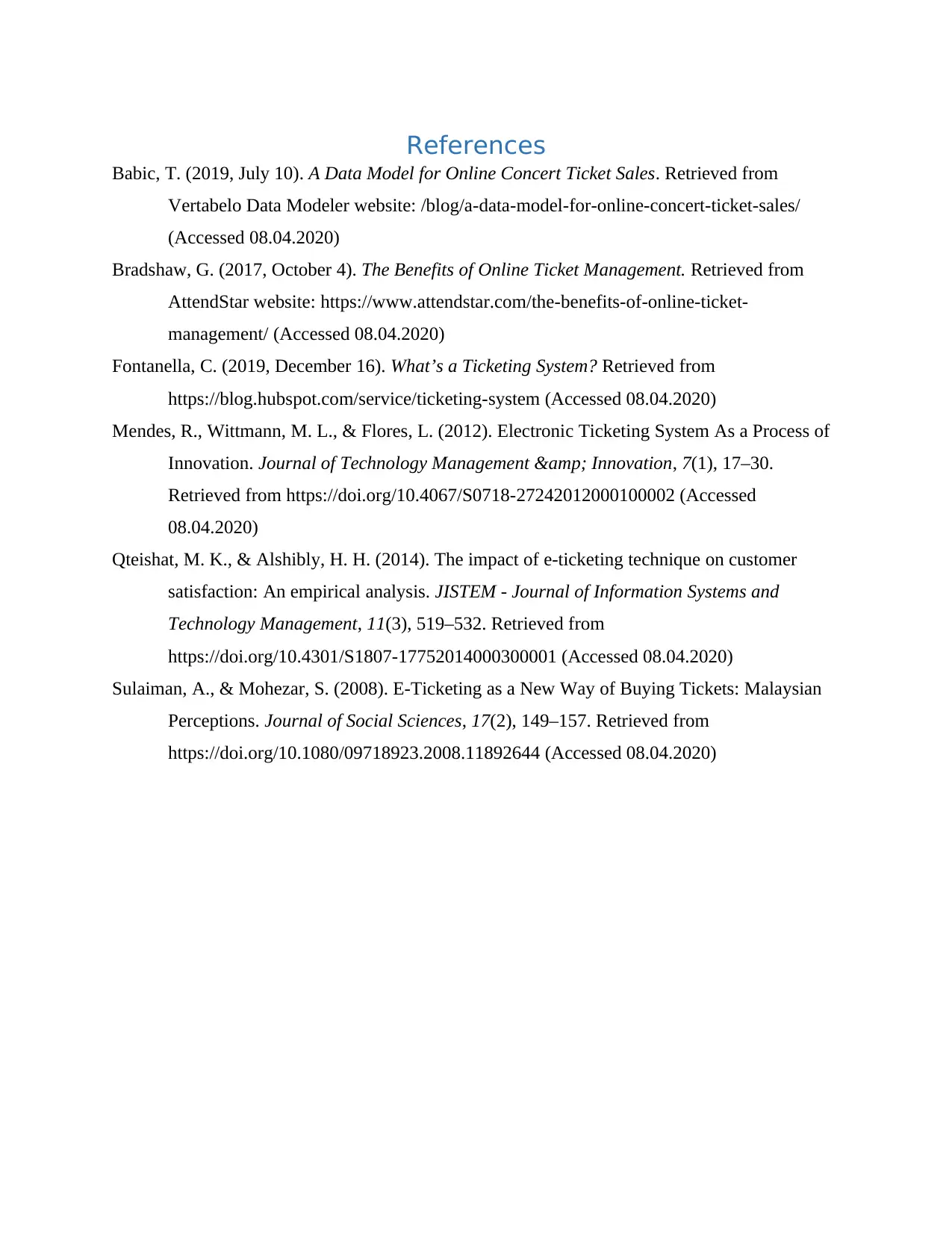
References
Babic, T. (2019, July 10). A Data Model for Online Concert Ticket Sales. Retrieved from
Vertabelo Data Modeler website: /blog/a-data-model-for-online-concert-ticket-sales/
(Accessed 08.04.2020)
Bradshaw, G. (2017, October 4). The Benefits of Online Ticket Management. Retrieved from
AttendStar website: https://www.attendstar.com/the-benefits-of-online-ticket-
management/ (Accessed 08.04.2020)
Fontanella, C. (2019, December 16). What’s a Ticketing System? Retrieved from
https://blog.hubspot.com/service/ticketing-system (Accessed 08.04.2020)
Mendes, R., Wittmann, M. L., & Flores, L. (2012). Electronic Ticketing System As a Process of
Innovation. Journal of Technology Management & Innovation, 7(1), 17–30.
Retrieved from https://doi.org/10.4067/S0718-27242012000100002 (Accessed
08.04.2020)
Qteishat, M. K., & Alshibly, H. H. (2014). The impact of e-ticketing technique on customer
satisfaction: An empirical analysis. JISTEM - Journal of Information Systems and
Technology Management, 11(3), 519–532. Retrieved from
https://doi.org/10.4301/S1807-17752014000300001 (Accessed 08.04.2020)
Sulaiman, A., & Mohezar, S. (2008). E-Ticketing as a New Way of Buying Tickets: Malaysian
Perceptions. Journal of Social Sciences, 17(2), 149–157. Retrieved from
https://doi.org/10.1080/09718923.2008.11892644 (Accessed 08.04.2020)
Babic, T. (2019, July 10). A Data Model for Online Concert Ticket Sales. Retrieved from
Vertabelo Data Modeler website: /blog/a-data-model-for-online-concert-ticket-sales/
(Accessed 08.04.2020)
Bradshaw, G. (2017, October 4). The Benefits of Online Ticket Management. Retrieved from
AttendStar website: https://www.attendstar.com/the-benefits-of-online-ticket-
management/ (Accessed 08.04.2020)
Fontanella, C. (2019, December 16). What’s a Ticketing System? Retrieved from
https://blog.hubspot.com/service/ticketing-system (Accessed 08.04.2020)
Mendes, R., Wittmann, M. L., & Flores, L. (2012). Electronic Ticketing System As a Process of
Innovation. Journal of Technology Management & Innovation, 7(1), 17–30.
Retrieved from https://doi.org/10.4067/S0718-27242012000100002 (Accessed
08.04.2020)
Qteishat, M. K., & Alshibly, H. H. (2014). The impact of e-ticketing technique on customer
satisfaction: An empirical analysis. JISTEM - Journal of Information Systems and
Technology Management, 11(3), 519–532. Retrieved from
https://doi.org/10.4301/S1807-17752014000300001 (Accessed 08.04.2020)
Sulaiman, A., & Mohezar, S. (2008). E-Ticketing as a New Way of Buying Tickets: Malaysian
Perceptions. Journal of Social Sciences, 17(2), 149–157. Retrieved from
https://doi.org/10.1080/09718923.2008.11892644 (Accessed 08.04.2020)
⊘ This is a preview!⊘
Do you want full access?
Subscribe today to unlock all pages.

Trusted by 1+ million students worldwide
1 out of 9
Related Documents
Your All-in-One AI-Powered Toolkit for Academic Success.
+13062052269
info@desklib.com
Available 24*7 on WhatsApp / Email
![[object Object]](/_next/static/media/star-bottom.7253800d.svg)
Unlock your academic potential
Copyright © 2020–2025 A2Z Services. All Rights Reserved. Developed and managed by ZUCOL.




